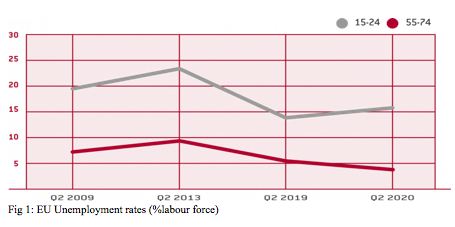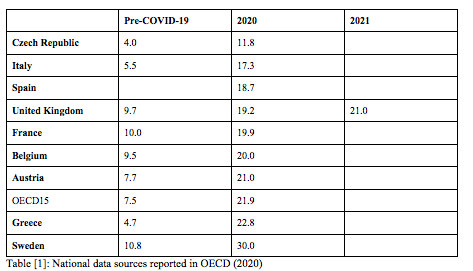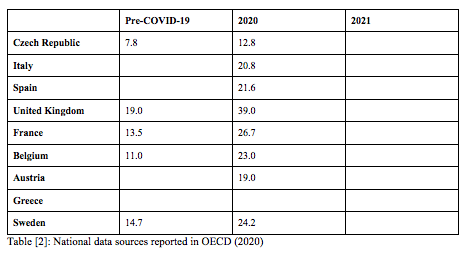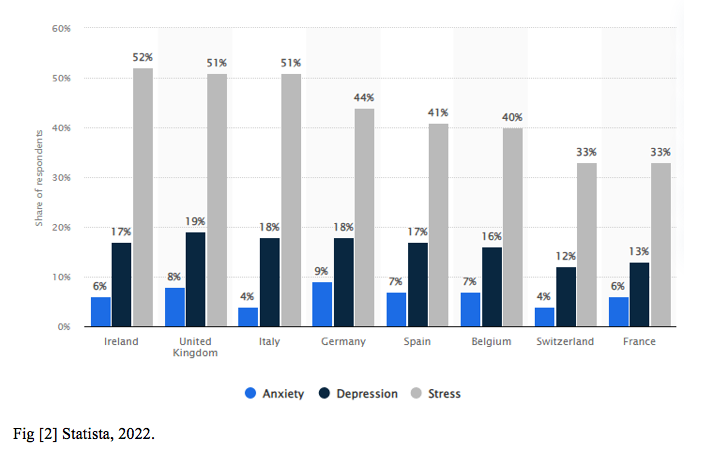The advent of the Covid-19 pandemic shook the world and changed how we lived, interacted, and moved around. This pandemic swiftly changed our lifestyle and existence in general with little or no time to prepare. The world was also denied some basic rights in order to ensure our safety such as the lockdown which infringed on our freedom to move.
In a feat of anxiety for what the future may bring and the quest for survival, the pandemic period saw the massacre and hoarding of store goods, especially tissue papers. A lot of people were isolated from their loved ones while some lost the battle to the virus.
It is not news that the mental health rate in European youths has been gradually deteriorating over the years, but with the pandemic, the numbers are projected to go from 10 to 20% of children dealing with mental health issues to about 20 to 25% of them [1]. The pandemic is projected to have long-term effects on the youth and these effects contribute largely to the decline of their mental health
In this paper, we’ll be taking a look at the following:
- Emotional and environmental stress
- Youth unemployment
- Situational analysis of different countries
Being stuck on lockdown or being held in quarantine put some people in a distressed emotional state as they had to navigate their lives with little to no human interaction for days, weeks and even months. There was the looming dread that the virus could get you if you made one wrong move. Hence, people stocked up on face masks, sanitisers and even gloves. People also had to deal with the passing of their loved ones whose bodies they were not allowed to bury themselves. Families stuck in different locations were separated because of the lockdown and weddings and other ceremonies couldn’t be held.
Amidst all of these, there were still people who felt differently about the pandemic. These people did not believe in the existence of the virus or that there was an outbreak. These were the people who refused to wear a mask or follow the safety protocols put in place to protect everyone. They endangered the masses and not only did some of them contract the virus, but they also spread it to others and increased casualties.
While youths seem to suffer fewer casualties from the effects of the virus, it has put a strain on their mental health. For example, students who used to have the option of going to school which protected them from some family traumas and provided them with a community of their peers no longer had that. They had to stay home to witness everything, both positive and negative, with nowhere to go for solace when they needed one.
The lockdown also put a lot of families under pressure as those with difficult working circumstances had to navigate through the pandemic. Single-parent households also had to make do with little to no environmental support and assistance. All of these leads to parental stress which shows negative effects on the children and youths. [2].
Another problem that affects the mental health of youths in Europe is the rate of youth unemployment brought about by the Covid-19 crisis.
Europe has struggled with a high rate of youth unemployment since the global financial crisis and while there have been significant efforts to tackle this issue, the Covid-19 pandemic threatened to make things worse. This reality is one that is hitting harder on the European youths.
The graph below highlights the rate of unemployment in the European Union by the percentage of the labour force. It shows the deteriorating effect of the pandemic on employment, especially on those aged 15-24. In the second quarter of 2020, the unemployment rate in Europe remained unchanged, the rate for those between 55-74 saw a slight decline but the rate for the youths, however, continued to rise [3].

Youth unemployment has been shown to have longer-term effects which in turn leads to a decline in their mental health. This issue of long-term unemployment usually causes a lack of optimism for the future and the lack of reasonable income tends to lead to a high mortality rate, divorce, childlessness, and inability to afford healthcare, all of which adversely affect one’s mental state of being. [4]
Situational Analysis of European Countries
A look at some of the countries in Europe shows a disparity in the rate of mental health conditions from the pre-COVID era till more recent times. These results show a huge increase in mental health cases since the pandemic, and the numbers seem to remain high.
National estimates of the prevalence of depression or symptoms of depression pre-COVID-19, in 2020 and 2021

National estimates of the prevalence of anxiety or symptoms of depression pre-COVID-19, in 2020 and 2021

National estimates of the prevalence of anxiety, depression and stress in 2022

In conclusion, the pandemic has left a negative impact on European youths and this fact cannot be ignored. There is a need to take action towards changing these statistics, helping the youth find a balance in the new world order and to start living instead of coping.
References
[1] Wayne Deeker [2022]. Horizon The EU Research & Innovation Magazine. https://ec.europa.eu/research-and-innovation/en/horizon-magazine/covid-generation-effects-pandemic-youth-mental-health
[2] Lehmann, S., Haug, E., Bjørknes, R. et al [2022] Quality of life among young people in Norway during the COVID-19 pandemic. A longitudinal study. Eur Child Adolesc Psychiatry. https://doi.org/10.1007/s00787-022-02023-5
[3] Grzegorczyk, M. and G. Wolff (2020) ‘The scarring effect of COVID-19: youth unemployment in Europe’, Bruegel Blog. https://www.bruegel.org/blog-post/scarring-effect-covid-19-youth-unemployment-europe
[4] Schwandt, Hannes; Wachter, Till von [2020] Socioeconomic Decline and Death: Midlife Impacts of Graduating in a Recession, IZA Discussion Papers, No. 12908, Institute of Labor Economics (IZA), Bonn. https://www.econstor.eu/bitstream/10419/215304/1/dp12908.pdf
Figures
Fig [1] Grzegorczyk, M. and G. Wolff (2020) ‘The scarring effect of COVID-19: youth unemployment in Europe’, Bruegel Blog. https://www.bruegel.org/blog-post/scarring-effect-covid-19-youth-unemployment-europe
Fig {2] Conor Stewart [2022] Prevalence of anxiety, depression, and stress in Europe in 2022. https://www.statista.com/statistics/1339498/feelings-of-anxiety-depression-and-stress-in-europe/
Tables
Table [1] Source: National data sources reported in OECD [2020] https://www.oecd.org/coronavirus/policy-responses/tackling-the-mental-health-impact-of-the-covid-19-crisis-an-integrated-whole-of-society-response-0ccafa0b/#figure-d1e205 Updated national data is included for Canada and the United Kingdom.
Table [2] Source: National data sources reported in OECD [2020] https://www.oecd.org/coronavirus/policy-responses/tackling-the-mental-health-impact-of-the-covid-19-crisis-an-integrated-whole-of-society-response-0ccafa0b/#figure-d1e205 Updated national data is included for Canada and the United Kingdom.


